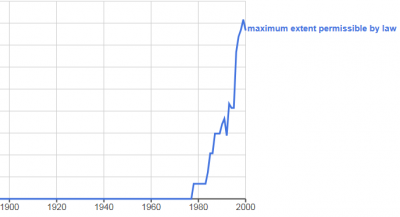To the fullest extent permissible by law: Difference between revisions
Amwelladmin (talk | contribs) No edit summary |
Amwelladmin (talk | contribs) No edit summary |
||
| Line 1: | Line 1: | ||
{{ | {{a|plainenglish|[[File:Maximum extent permissible by law.png|400px|thumb|right|Unknown before 1978, this ghastly phrase has flourished in the intervening years. Source: Google]]}} | ||
It won’t be long in the life of a young [[Mediocre lawyer|lawyer]] before {{sex|she}} comes across this delightfully {{f|flannel}}led [[subordinate clause]]: | It won’t be long in the life of a young [[Mediocre lawyer|lawyer]] before {{sex|she}} comes across this delightfully {{f|flannel}}led [[subordinate clause]]: | ||
Revision as of 17:40, 6 January 2020
|
Towards more picturesque speech™

|
It won’t be long in the life of a young lawyer before she comes across this delightfully flannelled subordinate clause:
To the maximum extent permissible by law,...
She might pause briefly, on that first fumbling encounter, and wonder what legal mischief this incantation is calculated to ward off. Does the law assume that any contractual provision is deemed, unless you say to the contrary, to be half-hearted in its intent — a choked nine-iron back onto the fairway from behind a tree, and not a full-throated drive at the green?
God only knows, is this commentator’s remark. But a bit of research suggests that this gem found its way into the forensic world some time in the late 1970s. And as you'll see to the right[1], it has flourished since its introduction.